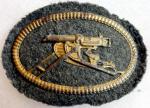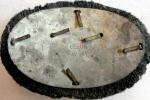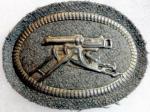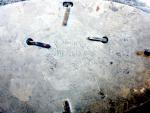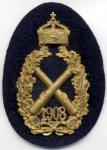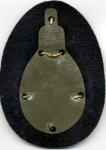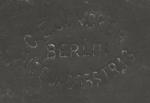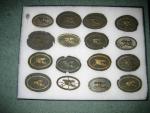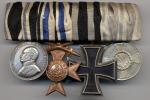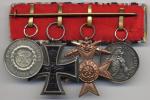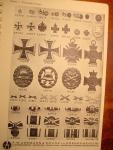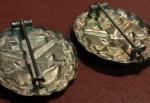-
Posts
3,591 -
Joined
-
Last visited
-
Days Won
3
Content Type
Profiles
Forums
Blogs
Gallery
Events
Store
Everything posted by dond
-
Juncker badges are easy to spot on period photos due to the thickened left front leg (the viewers right) on the sled. The initial badge submitted for approval had a thin leg in that place and was subject to breaking, possibly when the badge was bend to form a convex shape for wearing on the arm. The tabs also got larger and less refined, perhaps due to the use of unskilled labor or just the elimination of extra manufacturing steps due to the need to pump them out by the thousands.
-
We will start with the Juncker firm. Juncker had a long history of supplying military equipment and insignia to the German Army. That makes it a logical start point for us as we can find other Juncker items with the same construction characteristics as the MG badge. First let's look at a Kaiser preis (shooting award) made by the firm. Note the construction on the reverse, thin pointed pins and the maker mark.
-
By late 1915 the Germans and Allies both realized the war would not be over quickly. Each side started to develop strategies for the conduct of a long war. The Allies, whom had the burden of ejecting the Germans from the occupied parts of the continent opted for massive artillery investments. The Germans, with their limited manpower and material shortages settled on the machine gun. Both sides had learned that keeping masses of troops in the front line only led to heavy casualties. They had also learned that one machine gun, properly sited and well supplied with ammo, could stop a whole battalion of attacking infantry in their tracks. So even as the Allies prepared to blast the Germans in a hailstorm of high explosive and shrapnel fires, the Germans realized that if even only a few machine guns survived they were sufficient to hold off the Allies and prevent a breakthrough until a counter attack could be organized. So the Germans designed a defense in depth with a thin crust on the front line and defensive belts in support of them. What started out as Machine Gun Sharp Shooter Detachments (MSSA) would eventually be built up to battalion sized units assigned to the different Army Corps and doled out to the front line Divisions as required. From concrete dugouts and hidden emplacements in the 2-3 defensive lines they would poor a withering fire into the massed infantry attacks. Indeed, if you read unit histories from the period, both German and Allied, the common soldiers all talked about the massive artillery bombardments (drumfire as the Germans on the receiving end called it) and the chattering of the machine guns as the attacks were launched. For the Allied troops, this machine gun fire was more defining towards their personal experience as they watched whole platoons bowled over by single guns. To make this concept work, the Germans drew combat proven soldiers from the front line troops and sent them to school to master their craft, the employment of the guns. The exact subjects covered has been lost to time but can be surmised based upon what armies teach today, operating the gun, reducing stoppages, traversing fire, plunging fire, grazing fire, interlocking fields of fire etc.... To denote these troops as specialists they were awarded a specialty badge. It consists of an MG08 mounted on the period sled and surrounded by a stylized ammunition belt. Under this was a field gray cloth oval that allowed the badge to be sewn to the sleeve. This was held in place by a backing plate thru which ran tabs from the reverse of the badge and were then bent over. There were several period makers of these badges including Juncker, Falkenburg Richter, Carl Leberg, Mayer&Wilhelm etc... Construction techniques were typical of the period as we shall see.
-
Ditto......
-
Thanks. Too bad the jeweler didn't put his mark on it.
-
Very nice Ralph. What does the other side look like?
-

EK 1914 American themed EK doc.......
dond replied to Chris Boonzaier's topic in Germany: All Eras: The Iron Cross
Belleau Woods eh? -
Probably to be in close proximity to the locals. Good PR.
-
I wonder what the officer that sited the combat outpost in a spot that had commanding terrain on all four sides got......
-

EK 1914 Ugly and cheap....
dond replied to Chris Boonzaier's topic in Germany: All Eras: The Iron Cross
That core looks like a cast core. That would conceivably make it an early one, like wartime. -

EK 1914 Ugly and cheap....
dond replied to Chris Boonzaier's topic in Germany: All Eras: The Iron Cross
Mid to late 30s at least imo. -

EK 1914 Ugly and cheap....
dond replied to Chris Boonzaier's topic in Germany: All Eras: The Iron Cross
What do you expect from a TR era produced cross?



